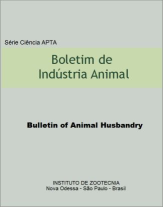Sensitivity of two strains of haemonchus contortus to albendazole
Palavras-chave:
albendazole, egg hatch test, Haemonchus contortusResumo
Gastrointestinal parasites cause high economic losses in small ruminant production and this problem has worsened because helminths have developed resistance to many of the commercial anthelmintics. In the state of São Paulo, studies have detected this problem in approximately 90% of the farms. Haemonchus contortus is the most prevalent and resistant helminth, and causes the greatest loss to small ruminant production. Albendazole (ABZ) is an anthelmintic which, although the related efficacy is below the expected values, is still widely used for the control of gastrointestinal parasites. The identification of the sensitivity and/or resistance profile of the strain for a specific commercial anthelmintic is an essential step for standardization of in vitro diagnosis tests. The objective of this work was to evaluate the sensitivity/resistance profile of two strains of H. contortus against ABZ at a concentration of 0.1 mg mL-1 in the in vitro egg hatch test. One of the two tested strains is resistant (previously validated as resistant to albendazole, ivermectin, levamisole, trichlorfon and closantel). This strain was compared with a sensitive strain (which requires validation). About 100 eggs of each strain were exposed to ABZ diluted in distilled water at pH 7. Each strain was tested with 6 replicates in a 48-well polystyrene plate and incubated for 24 hours at a temperature of 27°C. The hatchability was evaluated under an inverted microscope to count the number of hatched and non-hatched eggs. Data were evaluated by analysis of variance analysis to compare the efficacy of the strains. Data presented normality (Kolmogorov-Smirnov test) and homogeneity of variance (Levene test). The resistant strain was different from the susceptible strain (P<0.01). The mean efficacy of ABZ on the susceptible strain was 85.25 ± 4.75% and the mean efficacy on the resistant strain was 12.81 ± 7.48% at 0.1 mg mL-1. These data indicate the resistence of one susceptible and one resistant strain, which is important to be considered as positive and negative standard controls for the development of commercial tests to detect anthelmintic resistance to ABZ.
Downloads
Downloads
Publicado
Edição
Seção
Licença
Os autores não serão remunerados pela publicação de trabalhos, pois devem abrir mão de seus direitos autorais em favor deste periódico. Por outro lado, os autores ficam autorizados a publicar seus artigos, simultaneamente, em repositórios da instituição de sua origem, desde que citada a fonte da publicação original seja Boletim de Indústria Animal. A revista se reserva o direito de efetuar, nos originais, alterações de ordem normativa, ortográfica e gramatical, com vistas a manter o padrão culto da língua e a credibilidade do veículo. Respeitará, no entanto, o estilo de escrever dos autores. Alterações, correções ou sugestões de ordem conceitual serão encaminhadas aos autores, quando necessário. Nesses casos, os artigos, depois de adequados, deverão ser submetidos a nova apreciação. As opiniões emitidas pelos autores dos artigos são de sua exclusiva responsabilidade. Todo o conteúdo deste periódico, exceto onde está identificado, está licenciado sob a Licença Creative Commons Attribution (CC-BY-NC). A condição BY implica que os licenciados podem copiar, distribuir, exibir e executar a obra e fazer trabalhos derivados com base em que só se dão o autor ou licenciante os créditos na forma especificada por estes. A cláusula NC significa que os licenciados podem copiar, distribuir, exibir e executar a obra e fazer trabalhos derivados com base apenas para fins não comerciais.













